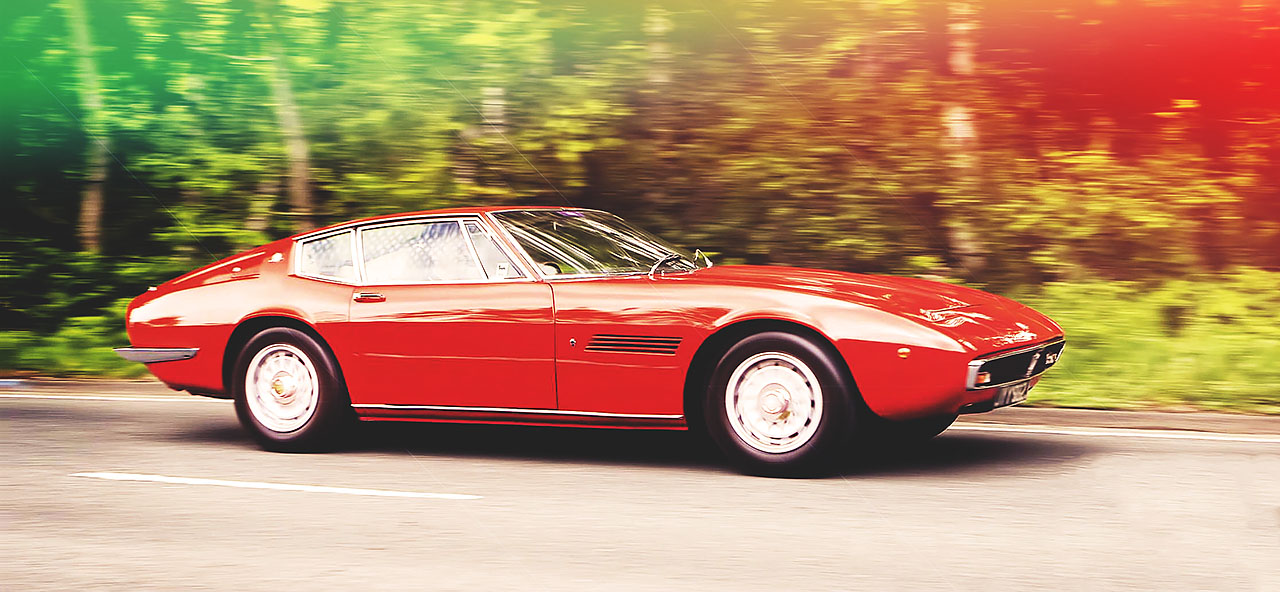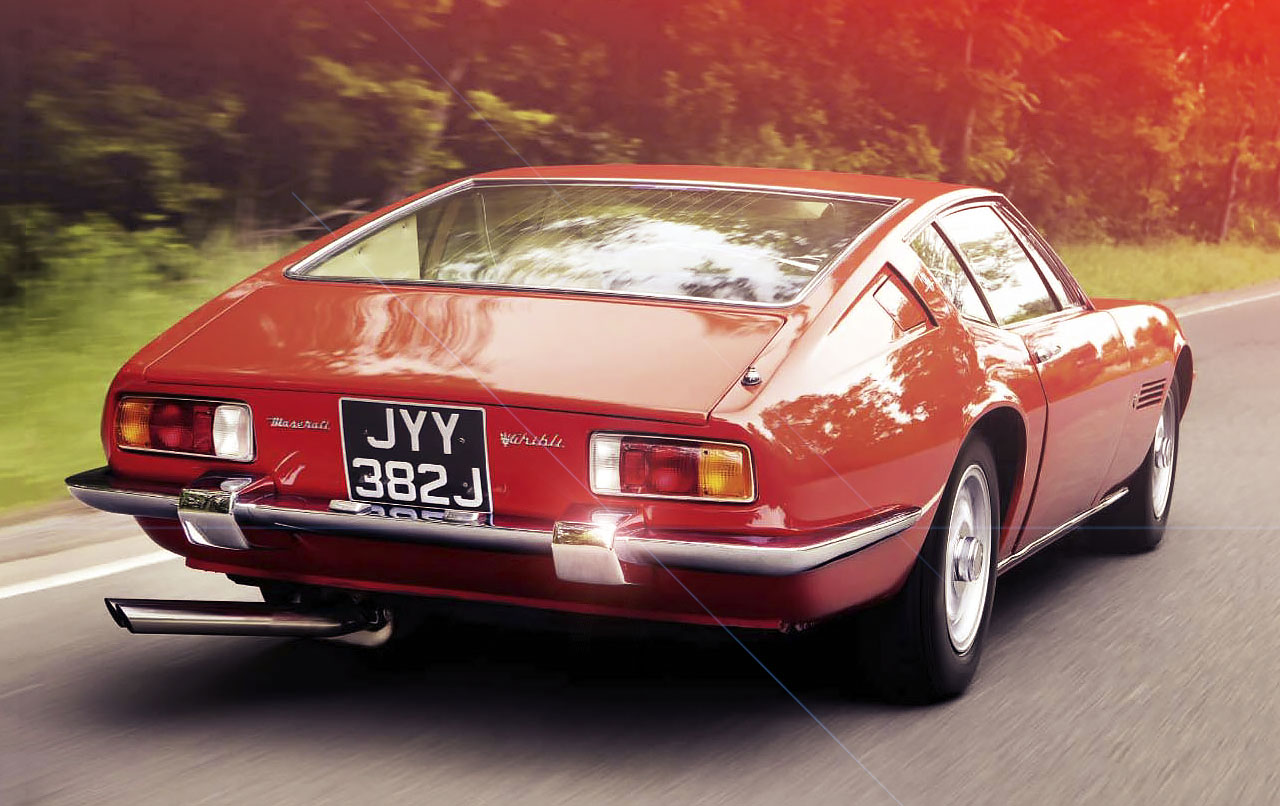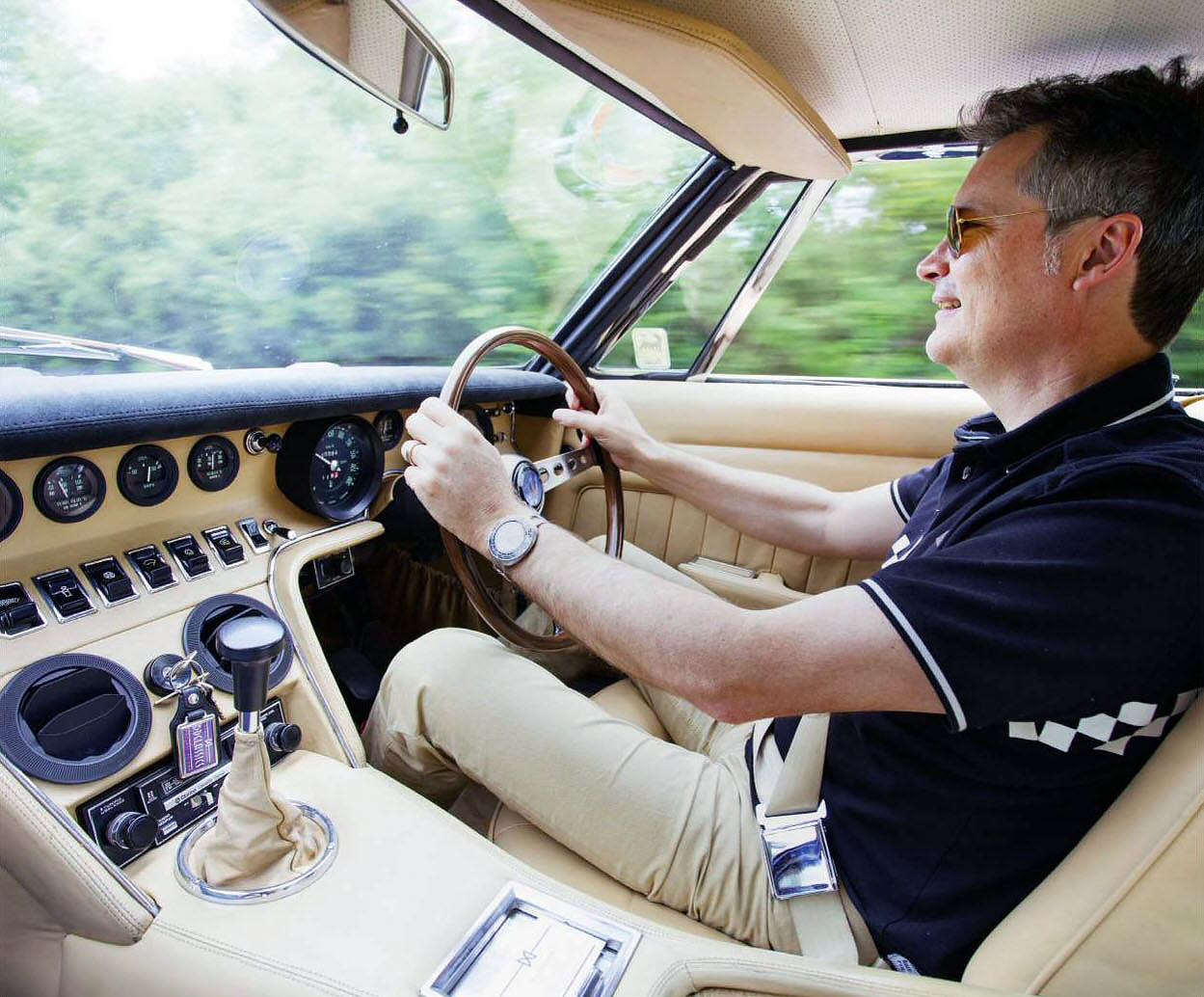
Reader Richard Head has wanted to drive a Maserati Ghibli since he heard an owner describe it as the best car ever. We give him the chance to discover if that’s true. Richard Head has wanted to drive a Maserati Ghibli since he heard it described by an owner as the best car ever. We give him the chance to find out. Words Ross Alkureishi. Photography Neil Fraser.
Richard Head His diverse car CV includes a London FX4 Taxi – in which he toured France as a student – Bertone X1/9 and Subaru SVX. Today Environmental Manager Richard Head’s toys include a trio of BMWs – 3.0 CSL E9, M635 CSi E24 and Z1, as well as Lamborghini Silhouette.

HIS WISHLIST
Maserati Bora
Porsche 911 (Pre-’73 Targa)
Mini Cooper S
Maserati Ghibli SS
Facel Vega HK500
Studebaker Avanti
I get the train to work in Chiswick. Each day it stops at Kew Station, and I look out to see what DD Classics has in the window,’ explains Richard Head, who sent his wish list to Classic Cars. ‘I’ve often thought I’ll knock off a bit early today and pop in… Now here I am.’ Here he is indeed and here too, parked by the pavement, is a bright red 1970 Maserati Ghibli SS, ready and waiting. ‘Absolutely beautiful,’ he says, taking in its long sleek profile. ‘If you were a kid and you drew a car, this would be it.’
But for some reason he’s frowning. ‘I have a bit of an issue with the colour, if I’m honest. Ferraris are red, Lamborghinis are your ridiculous new kid on the block kind of rebel colours, but if I was going for a GT Maserati I’d have something more dignified and gentlemanly.’ A fair point – its Giugiaro-penned lines do look better in more subdued metallic tones, but from the look on his face now I can tell it’s not going to detract from what’s about to follow. ‘It looks like a speedboat and even stationary, at the side of the road, it’s as if it’s doing 100mph.’
‘This is a supercar, man. There’s got to be a barrier to entry, it should be hard’
John Barlow of DD Classics hands over the keys. ‘Ever sampled one?’ he asks us both. ‘No,’ we answer in unison. ‘I’ve scooted it around London quite a few times and it’s more like driving an American car, such as a Mustang.’ Intrigued, we lower ourselves down into the Ghibli’s cabin with Richard at the helm. It’s deceptively spacious and luxuriously finished; there’s an acre of luggage room in the rear, and occupants sit low down with an epic upward view over the long bonnet. ‘It’s a comfortable driving position,’ says Richard. ‘But I do feel like we’re about to take off.’ A key turn starts the fuel pump, filling the cabin with a vociferous metronomic ticking – think Tick-Tock, the crocodile from Peter Pan – before a further twist sees the big V8 rumble into life.

There’s one incongruous item in here – the handbrake. Situated in the driver’s footwell it looks about two feet long, with the handle resembling that of a Victorian policeman’s truncheon. Richard reaches down to release it but he’s bound tight by a fixed seatbelt. I lean over to see if I can get it, but to no avail. A couple walking by give strange looks to the two grown men in the red sports car, bent double, fumbling around.
Anchor finally free – after a seatbelt release – my driver starts to manhandle this non-power-assisted car away from the kerb. ‘I hope you had spinach for breakfast,’ I offer, in response to hearing his efforts. ‘This is a supercar, man. There’s got to be a barrier to entry, it should be hard,’ he says, laughing. ‘Any classic car should have its idiosyncrasies, but Italian ones more.’
As the Ghibli approaches a big speed bump we both breathe in, unsure just how low this car sits. We needn’t have worried. Despite being just 3ft 9½in tall, the use of dry sump lubrication ensures its aesthetics don’t compromise ground clearance.
‘The steering is much lighter at speed,’ says Richard. ‘It’s actually quite easy to drive, not intimidating at all,’ he adds, re-evaluating his earlier statements. ‘With the name Maserati you expect highly 4.9-litre V8 produces 335bhp in SS trim, around 20bhp more than the standard 4.7-litre Ghibli strung but the engine seems relaxed; power takes a while to build up, though; maybe I need to take it higher up the rev range.’ It’s a Friday morning just after rush hour so, while the traffic has lightened, it’s still a relatively slow crawl out of the capital. The car’s colour and sleek-lined combination is ensuring plenty of attention – perhaps red’s no bad thing after all. ‘The clutch isn’t that heavy,’ says my driver, thankfully. ‘Imagine hill starts with that comedy handbrake if it were?’ The ZF gearbox is also winning him over. ‘It’s a bit knobbly, especially when I take my foot off the throttle, but I quite like that mechanical connection.’
As we join the M4 the road clears and Richard starts to open it up; a potent rumble fills the cabin, the nose rises and we start to devour tarmac. Half an hour of motorway cruising later we come off for some cross-country work. I’m wondering if he’s thinking the same as me – nice car, but what’s all the fuss?
Dry sump engine helped Giugiaro achieve that seductively low bonnet line that turned Richard’s head. Suddenly, I’m brutally pinned back in my seat, the cabin transformed into an aural cathedral to all things mechanical. Richard has finally taken his own advice. ‘I’ve been driving this all wrong,’ he says, smiling. ‘Look, it needs the revs. I’ve been shifting too early because I thought the engine wanted it, but it doesn’t come alive until 3000rpm and it needs to go right through to 5500rpm. It’s not a rev limit now, it’s a space on the road limit,’ he adds, nailing the throttle again. ‘Just, listen to that music!’
Both car and driver are transformed – it’s now full fat, after the skinny version we’d been experiencing. ‘I thought I knew Italian V8s but this is totally different from what I’m used to. My Lamborghini spins so fast to its 7500rpm redline; this one doesn’t move through that quickly but it still wants those revs. It all happens above 3000rpm, and that’s where it needs to be. It’s a hybrid, American low-end-like grunt but still the Italian high end.’ Emptying the left fuel tank and swapping to the right via a dashboard rocker switch prompts a driver change. Behind the wheel I identify the culprit for our initial driving experience – the accelerator mechanism. The pedal has a strange hinging movement, one that doesn’t encourage full engagement; I almost have to lift my entire foot over and then drop it down for it to open completely, but when it does 354lb ft of torque booms along in an instant, providing staggering levels of acceleration.
The braking prowess comes as a bit of a surprise; vacuumassisted Girling discs, with ventilated rotors all round, were highly specified for the time and 45 years on they still impress, allowing me to shave off speed in an instant. At the other end of the technology spectrum is the Ghibli’s rear suspension; it’s not just the V8 engine that has links to the preceding decades, but a live axle carried on semi-elliptic leaf springs, with just a torque reaction arm – located on the offside – to stop all that power folding the springs over like a Bologna sandwich. Yet it works. The handling is predictable, with the car giving a surprising amount of poise.
The steering feels a little low-geared, and a touch vague, for such a big vehicle, and fast through long sweepers there’s an element of correction necessary. I wonder if the optional power-assisted system is any more precise, or simply removes the necessary effort at low speed. But that’s a minor grumble and doesn’t detract from the main show – a glorious race-derived V8. It makes this one of the all-time great GTs, one that keeps me grinning like a fool.
For the journey back to London I hand the keys over to Richard once more and he’s instantly in the zone, keeping the revs high – even pulling away in first – and using the full range of the torque band. It’s thrilling outside-lane, traffic-devouring stuff. ‘I didn’t grab it by the scruff of the neck early enough,’ he explains. ‘I was tiptoeing around it, probably being too respectful. It needs to be driven hard, and responds best to that.’
It’s been an epic drive today, and one that demonstrates the need to spend enough time getting to know a classic car – even more important if you’re buying one. If we’d given it back after an hour, we’d probably both have thought ‘Yep, that was nice…’ but once its hard-edged alter ego made itself apparent the Ghibli changed into an entirely different car.
Richard said driving a supercar should be hard, but with this it’s not. There are no histrionics and the only real compromise is the heavy steering, and finding a powerassisted car resolves that. Richard’s happy, driving with ease and now tapping the steering wheel, singing ‘My Maserati does 185. I lost my licence, now I don’t drive…’ I meet him with a nonplussed look. ‘Joe Walsh, Life’s Been Good?’ he asks. ‘Wrong generation, sorry,’ I reply, deadpan.
As we pull up I ask if its place in his dream garage is secure. ‘I would buy one. It could be the best GT in the world; it has the looks, the pace, the luggage space, and a relaxed – yet wild, when you need it – engine to make a grand tour a joy. Is it more desirable than a Ferrari Daytona? Yes, to me it is,’ he replies. How does it live up to the original claim to the title of ‘best car in the world’ by the former owner of his Lamborghini Silhouette? ‘It could be, but if it’s not, then I’d bet the best car is one of the others on my List. I need to try the others…’
Thanks to: Daniel Donovan Classics (ddclassics.com)
FROM TRACK TO SHOWROOM MASERATI’S RACE-BRED V8
The 450S’s career ended with disbandment of the marque’s racing team in the 1957 season, yet its engine powered on until 1990.
Say Maserati and you instantly think racing heritage. That’s because the links run throughout its history like the V8 engine that powered many of its roadgoing Grand Tourers.
Originally commissioned by Southern Californian businessman Tony Parravano, two 4.2-litre V8 engines were built with banks at a 90-degree angle and two overhead camshafts each. The idea was to fit them in a Kurtis chassis for an assault on the Indianapolis 500, but the project never got off the ground.
Instead Maserati began the development of a sports racing car – Tipo 54, the 450S – to challenge Ferrari in the World Sports Car Championship. Now with a bore and stroke of 93.8mm x 81mm and enlarged to 4477cc, it featured aluminium cylinder heads with two plugs per pot, and an aluminium cylinder block featuring a five-mainbearing crankshaft and lightweight aluminium pistons. Power was 400bhp at 7200rpm, with later versions adding 20bhp.
During the 1957 season the race cars were beset by numerous crashes and breakages, but came within a whisker of taking the title. With the parent company haemorrhaging money, the team was disbanded and the 450S’s career ended. That should have been that, but the Shah of Iran commissioned a road-friendly 450S, with the result being the 5000GT. An exclusive grand tourer, powered by a 450S-devised engine, only 33 examples were built.
‘Incredibly, the first two actually had proper race engines in them,’ says Andy Heywood of McGrath Maserati. ‘But they realised that wasn’t practical and started to develop the road car version.’
The racer’s gear-driven camshaft layout was swiftly replaced by a more roadfriendly chain-driven arrangement. ‘There were many different variants of that early engine, with different capacities. Some had carburettors, others had Lucas fuel injection; some were wet sump, others dry. Giulio Alfieri was experimenting.’
Further development continued with it powering the Quattroporte, Mexico, Indy and Ghibli models. It was the last that proved to be of most interest with its racingtype dry sump design – a return to its roots – allowing the production of incredibly low and lithe bodywork. By now the V8 had morphed into an extremely smooth and sophisticated production engine but it was by no means done. It would continue to power the top models in the Maserati range before finally bowing out in 1990 after an incredible 33 years as a production road car engine. ‘It’s a terrific design,’ says Andy. ‘And is a reflection of the man that built it. He was about making sophisticated cars and producing something civilised to drive.’
‘Two cars were ordered with race units to create what must have been the hairiest of beasts’
4930cc V8 — part of Maserati’s bid for the Sports CarWorld Championship. Stunning looks – and great luggage space too.
TECH DATA 1970 MASERATI GHIBLI SS
Engine 4930cc all-alloy V8, dohc per bank, four Weber 40DCNF carburettors
Power and torque 335bhp @ 5500rpm; 354lb ft @ 3500rpm
Transmission Five-speed ZF manual, driving rear wheels Brakes Ventilated discs all round, servo-assisted
Suspension
Front: independent by wishbones, coil springs, telescopic dampers, and anti-roll bar. / Rear: live axle, semi-elliptic leaf springs, radius arms, torque reaction bar telescopic dampers, anti-roll bar.
Steering Recirculating ball, optional power-assistance
Weight 3637lb (1650kg)
Performance 0-60mph: 6.0sec; top speed: 174mph
Fuel consumption 15mpg
Cost new £11,615
Value now from £150,000
‘I was tiptoeing around it, probably being too respectful. It needs to be driven hard, and it responds best to that’

Richard enjoyed the Ghibli’s physicality and top end power
THE EVOLUTION
1956 450S
The Tipo 54 was a fearsome race car developed for the FIA World Sportscar Championship and was raced by Stirling Moss and Carroll Shelby. It featured a 90-degree 4.5-litre V8 engine and five-speed transaxle. Initial power output was around 400bhp – later cars had more – but all were somewhat underdeveloped and overpowered. Only one prototype and nine examples were built.
1959 5000GT
The jewel in the post-war, roadgoing Maserati crown, the 5000GT boasted huge performance – 170mph and 0-60mph in 6.5sec – thanks to the quadcam V8, inherited from 450S racer. Initially with gear-driven camshafts and four Weber carburettors, a chaindriven unit with Lucas fuel injection replaced this in 1961. Only 34 built, bodied by seven different coachbuilders, though 22 were by.
1963 QUATTROPORTE
The Italian car that made its equivalent to the English term ‘fourdoor’ sexy. Capable of 130mph, this highperformance luxury saloon took the title of fastest four-door car in the world. The Quattro- Porte’s sleek bodywork was courtesy of Frua on a tubular steel chassis, and it was powered by a 4.1-litre version of the quad-cam V8, which later grew to 4.7-litres.
1965 MEXICO
Notchback coupé styled by Michelotti and built by Vignale. Mechanically it was essentially a Quattroporte on a shortened wheelbase, so it featured the same engine and gearbox choices but had air-con as standard from 1969. Despite heavy kerb weight and mid-teens mpg, its performance was strong with a 260bhp V8 capable of 0-60mph in 7.5sec.
1966 GHIBLI
Exquisite Guigiaropenned lines with a shortened Mexico chassis underneath. That meant it had the same outdated live rear axle and leaf springs. Mechanicals were also identical save for its larger 4.7-litre version of the Maserati’s trusty quad-cam V8 – now in dry-sump configuration – and a higher power output of 330bhp. The drop-top Spider – only 125 built – arrived in 1969.
1970 GHIBLI SS
Now the quad-cam V8 was bored out to 4930cc to meet tighter US emissions standards. On paper the power hike was only 5bhp, but it meant torque was significantly higher and knocked 0.5sec off the 0-60mph time. Stunning looks, lavish interior and prodigious grunt ensure its ranking as one of the all-time great grand tourers. Production ended in 1973.





